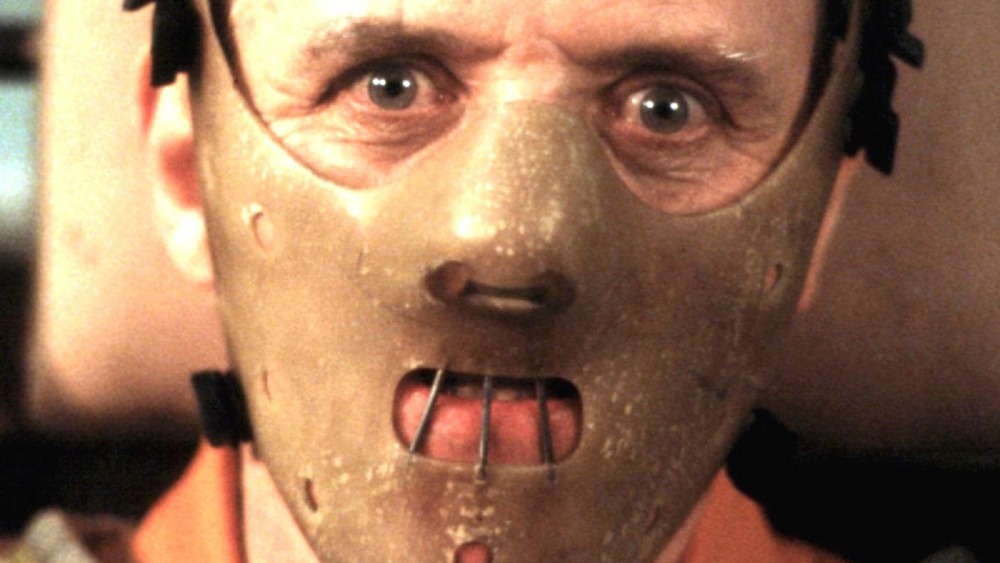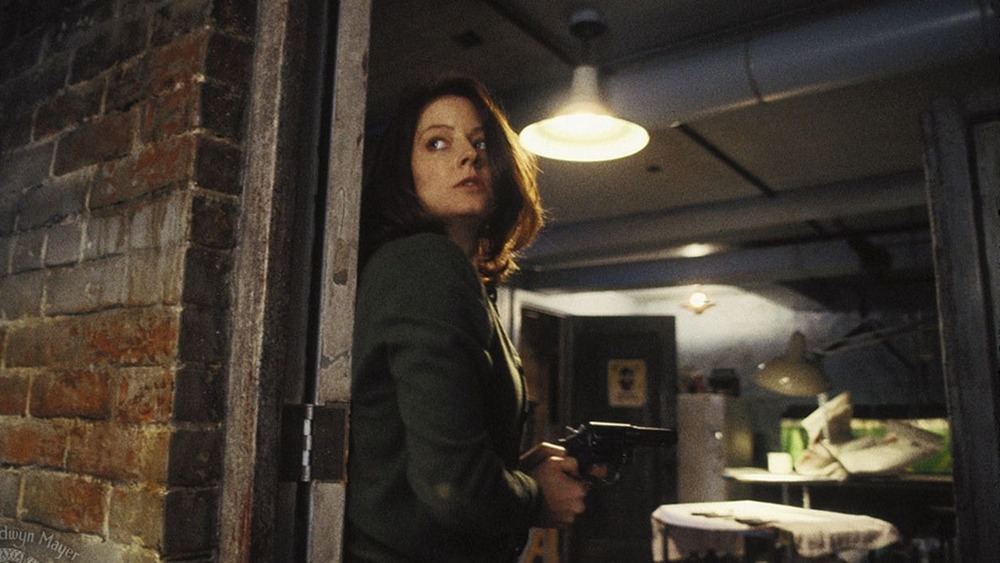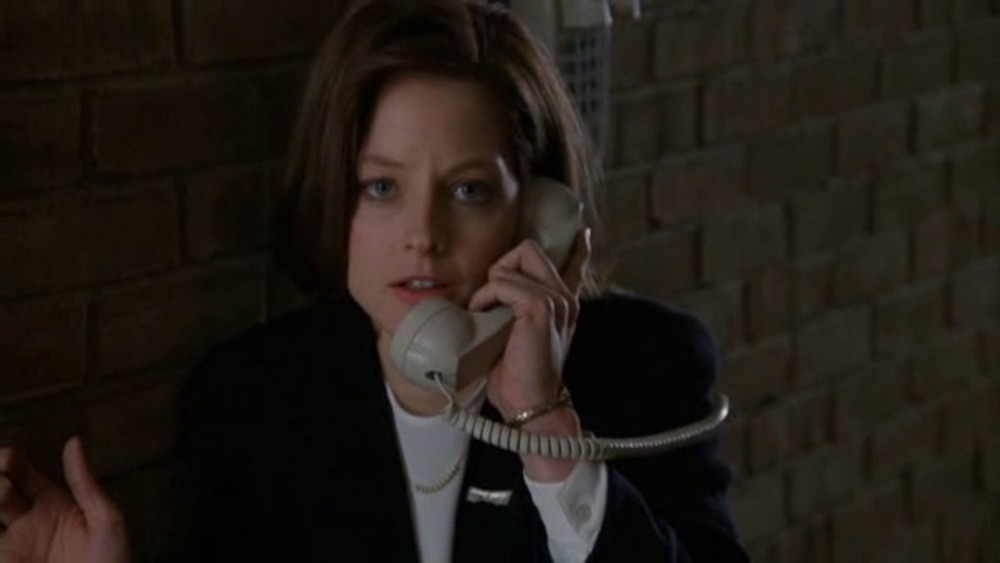The Ending Of Silence Of The Lambs Explained
The Silence of the Lambs is a film that has resonated throughout pop culture for three decades since coming out in 1991. It is, of course, the story of rookie FBI agent Clarice Starling (Jodie Foster), who develops an uneasy partnership with imprisoned, cannibalistic serial killer Dr. Hannibal Lecter (Anthony Hopkins) in hopes of apprehending a marauding murderer known as "Buffalo Bill" — and she must race against the clock, as the killer has recently kidnapped the daughter of a senator. Based on the 1988 novel by Thomas Harris (the sequel to his 1981 work Red Dragon), the movie dropped like a bomb on the pop culture landscape. Lecter had been played onscreen before — by the great Brian Cox, in director Michael Mann's 1986 Red Dragon adaptation Manhunter — but Hopkins' portrayal, all piercing gaze and coiled, barely-restrained intensity, became instantly iconic, as did the film itself. It is, thus far, the only horror movie to have not only won the Academy Award for Best Picture, but to sweep all five major categories, also winning for the direction of Jonathan Demme (previously best-known for the Talking Heads' concert film Stop Making Sense), Ted Tally's screenplay, and lead performances from Foster and Hopkins.
Foster's characterization of Starling as a sharp, perceptive, quietly driven investigator with her own significant underlying traumas and insecurities is masterful, yet subtle. Throughout the movie, her judgment and ability is called into question by her FBI trainer, her peers, and Lecter himself (although Lecter's motivation is purely to manipulate). She's even hit on by Dr. Frederick Chilton (Anthony Heald) — the administrator at the facility for the criminally insane where Lecter is being held — when she first arrives to question him, which is illustrative of the dismissive and even condescending attitudes that she encounters during her pursuit of Buffalo Bill.
The manner in which Starling overcomes others' perceptions of her, and trusts her own instincts and judgment in spite of them, is key to understanding her actions in the film's unbearably tense third act — in which she stumbles across Buffalo Bill's lair with no preparation, no backup, and no plan.
Perceptions matter in Silence of the Lambs
During Starling's investigation into Buffalo Bill's crimes, she's surrounded by male colleagues — and their perceptions of her, and how they broadcast those perceptions, might have cracked a lesser agent. Throughout the movie, she's subject to leering, flirting, and condescension from the likes of Chilton, the local police present during her examination of a victim's corpse, and the male entomologists she consults when the pupa of a Death's-head moth is found in the throat of that victim. Starling never buckles in the face of this behavior, though, and even confronts her direct superior, Jack Crawford (Scott Glenn), after he dismisses her from a sensitive conversation about one of the crimes due to its sexual nature. "When I told that sheriff we shouldn't talk in front of a woman, that really burned you, didn't it?" Crawford asks her in the car afterwards. "It matters, Mr Crawford," Starling replies. "Cops look at you to see how to act." Crawford acknowledges her point — because he is, quite possibly, the only man in the film who respects Starling, with the exception of Lecter himself.
Every other man in the film thinks he has Starling's number — including Jame Gumb, A.K.A. Buffalo Bill. After the murderer lures Starling to his basement, he attempts to get the drop on her by dousing the lights, leaving the entire area in pitch black, and tracking her with night vision goggles. It's the creepiest, most skin-crawling distillation of the male gaze — and yet, despite her seeming disadvantage, Starling proves a bit more capable than the murderer had bargained for. As she stares into the darkness, wide-eyed and alert, he creeps up behind her with a pistol... and gives himself away with a cock of its hammer. Starling reacts instantaneously to the sound, whirling around and shooting the killer dead — once again overcoming a man whose self-perceived superiority over her ended up falling rather short.
There's a lot going on in The Silence of the Lambs' final scene
If the third act of The Silence of the Lambs has a lot to tell us about Clarice Starling, then its final scene likewise has some interesting knowledge to impart about Hannibal Lecter. In it, Starling receives an unexpected phone call from Lecter — who had escaped his incarceration in dramatic and bloody fashion earlier in the film — during a party for the FBI's recent graduates. Lecter keeps it brief, for obvious reasons; we see that he's in some tropical locale, watching Dr. Chilton, whom he absolutely despises, get off a plane. One might think that, after all of the tense conversations between Lecter and Starling (during which he extracted some pretty personal information from her in exchange for his insight into Buffalo Bill), the good doctor would be calling to threaten her, or to gloat about his escape — but this is not at all the case.
Lecter's question to her — "Well, Clarice? Have the lambs stopped screaming?" — is a reference to one of those very personal stories from Starling's childhood; Lecter wants to know if Starling is at ease now, having caught the killer and saved the senator's daughter. He then reassures her, "I have no plans to call on you, Clarice. The world's more interesting with you in it." Lecter put himself at great personal risk to make that call, and his purpose was to find out whether Starling was at peace — and to express his admiration for her. In those brief seconds, one of the most dangerous and terrifying villains in screen history showed Starling more respect than virtually any other man in the entire movie. In doing so, Lecter proves that he's not an unfeeling monster, but a human being — which is perhaps the creepiest aspect of his entire character.


